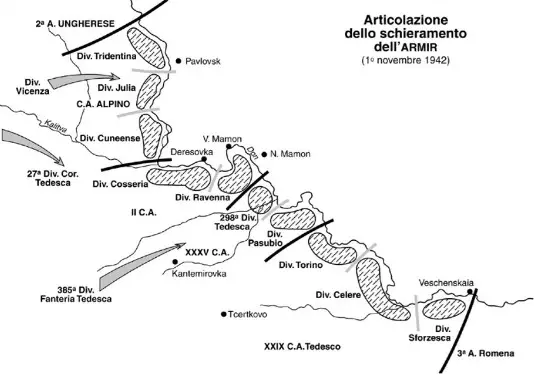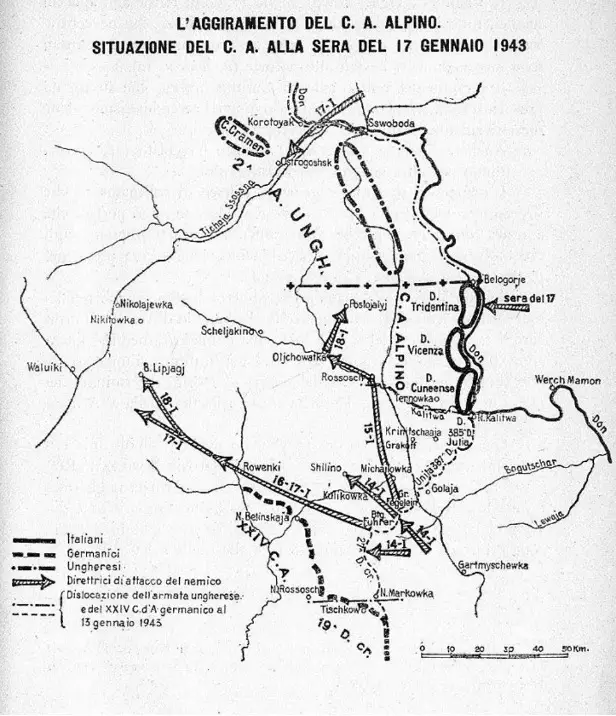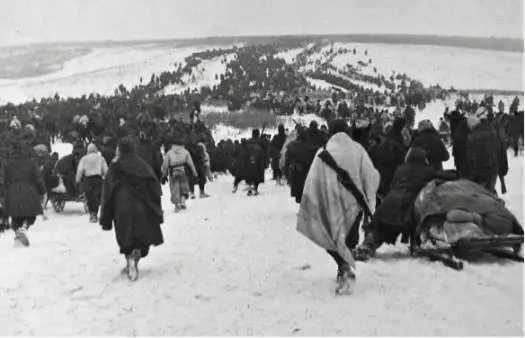Prelude to the storm
After the exhaustion of operation “Fall Blau”, the massive German push towards the Caucasus and Stalingrad, the Italian 8th Army (ARMIR) was deployed along the Don River, northwest of Stalingrad. Together with the 2nd Hungarian and 3rd Romanian army, plus some German divisions, these forces protected the north flank and rear of the German 6th Army fighting in Stalingrad. The epic battle for the city dragged all of Hitler’s attention as well as most of the Wehrmacht’s resources. These inevitably left the allied axis armies on the Don with not so much support in terms of armoured units and, at least in the case of the Italians, sufficient anti-tank guns. The Soviets perfectly knew that this section of the front was more vulnerable to a massive frontal assault involving hundreds of tanks and vehicles.
In November 1942, the ARMIR was deployed on the Don River in the following order: the Alpine corps (Cunense, Tridentina, and Julia divisions) held the left flank. The Cosseria and the Ravenna divisions held the centre, reinforced by the German 298° division. The divisions of the old CSIR (now XXXV corps) held the right flank (Pasubio, Torino, Celere). The “Sforzesca” division held the junction between the ARMIR and the Romanian army. The Division “Vicenza” and the German 27° Panzer and 385° divisions remained in reserve. The front held by the Italians was in total 230 km long.

The Soviet onslaught
On the 19th of November, the Red Army launched Operation “Uranus”, a large pincer movement aimed at encircling the German 6th Army fighting in Stalingrad. The offensive smashed into the 3rd and 4th Romanian armies, covering respectively the left and right flanks of the German 6th Army. For the rest of November, the Axis forces tried to mount several counterattacks against the soviet pincer movement, this was carried out by also using the German divisions held in reserve in the ARMIR sector. This left the Italians with no reserves other than the German 294th infantry division and the weak “Vicenza” division.

Scheme of Operation Uranus
However, towards the end of November and early December, the Germans moved again some reserves, especially anti-tank units, in the ARMIR sector, fearing another Soviet attack in the area. On the 11th of December, the Red Army launched a series of local assaults against the Italian divisions (mainly the Ravenna and Cosseria), aiming to weaken the enemy in preparation for the main thrust. All the attacks were repelled by the Italians but at the cost of high casualties and material attrition. On the 16th December, the main attack began, carried out by the 6th and 1st Soviet Armies, that could count on 170.000 men, 750 tanks and around 2.500 artillery pieces. The attack came in the centre of the front held by the Italians, the Ravenna and Cosseria divisions were annihilated within the first day of the fight and the survivors fled southwest. The Italian infantry fought bravely in its entrenched positions, however, the higher mobility of the enemy, coupled with the wide use of tanks, sealed the fate of the two divisions.

The soviets break the Italian front in the sector held by the Cosseria and Ravenna divisions
By the 18th of December, the Red Army had opened a wide gap in the front and its tanks continued to push forward. In the attempt of containing the breakthrough, the alpine division “Julia was recalled from the northern sector and deployed on the edge of the gap, facing east, together with the German 385° infantry division. South of the gap, another German division (the 298°) faced west towards the advancing soviet troops and protecting the left flank of the Pasubio division. Also in the southern sector, the Red Army tried to break through, particularly in the sector of the Pasubio and Celere divisions. The soviets gained some territory but didn’t break the Italian lines.
The retreat from the southern sector
On the 19th, the Germans ordered a retreat in this sector, due to the general collapse of the 3rd Romanian Army to the East. Thus, the divisions Sforzesca, Celere, Pasubio and Torino began to move towards their new destinations south and southwest. The retreat became a 10-day long march (mostly on foot) amid the snow and soviet attacks, with a general lack of supplies and ammunition. The retreating Italian divisions, mixed also with some German and Romanian units fought dozens of rear-guard action before stabilizing on the new positions on the 2nd January 1943.

Defensive positions of the ARMIR
The second offensive in the northern sector
In the sector north of the gap created by the destruction of the Ravenna and Cosseria division, Italian (Alpine divisions plus the Vicenza division) and German units repelled all the local soviet attacks and the situation progressively eased for a pause in the operations ordered by the Red Army. In January, the Red Army stroke again, this time hitting a section of the front held by German forces of the 387th infantry division and the Kampfgruppe Fegelein. The breakthrough occurred on the 15th of January, with hundreds of Soviet tanks moving northwest. The Alpine divisions repelled all the attacks coming in their direction, paying a heavy toll in terms of lives. In the same days, the Red Army penetrated the lines of the 2nd Hungarian army (North of the Italians) thus creating the real threat of complete encirclement of the Italian alpine corps.

Encirclement of the Alpine corps
Retreat and breakthrough at Nikolayevka
After 4 days of intense fighting, the Alpine corps and the Vicenza division started the retreat, together with other shattered German units, joined later also by the Hungarians. It was a race against time, amid the snow and below -20°C temperatures, trying to reach the axis lines before the Soviets could close the encirclement. In the following days, the soviet spearheads attacked the long axis column several times, also forming blockades along their march. The Alpini and their allies, with little heavy armament left, repelled many of the incursions and pushed through all the enemy blockades. One last obstacle was constituted by the soviet 48th Guards division, entrenched in the town of Nikolayevka. On the 26th of January, the depleted Apline divisions frontally assaulted Nikolayevka, in a desperate attempt to break through and reach friendly positions to the northwest. A true human wave hit the soviet positions and by the evening, the Italians had overrun the enemy defences, granting safe passage to the entire column of German and Hungarian survivors.


The retreat of the Alpine corps
Epilogue
On the 31st of January, the survivors of the Alpine corps reached the axis held town of Schebekino, finally receiving shelter and food. They had marched for 12days and 350 km. Of the 61.000 men that started the retreat, roughly 20.000. had survived. The Tridentitna division had 6.500 men remaining, the Cunense had 1.600, the Julia had 3.300 and the Vicenza had 1.300, around 7.000 men wounded or suffering from freezing. Together with the Italians, between 2.000 and 7.000 Germans and 2.000-6.000 Hungarians also escaped the encirclement. Down to the south, the other ARMIR units had suffered a similar number of casualties, including the destroyed Ravenna and Cosseria divisions.
On the 31st of January 1943, the ARMIR command was dissolved, and the survivors were progressively repatriated to Italy.
Sources
Schlemmer, T. (2005). Invasori, non vittime: la campagna italiana di Russia 1941-1943.
Ufficio Storico dello Stato Maggioredell’Esercito. (1946). L’ 8° Armata Italiana nella seconda battaglia difensiva del Don .
